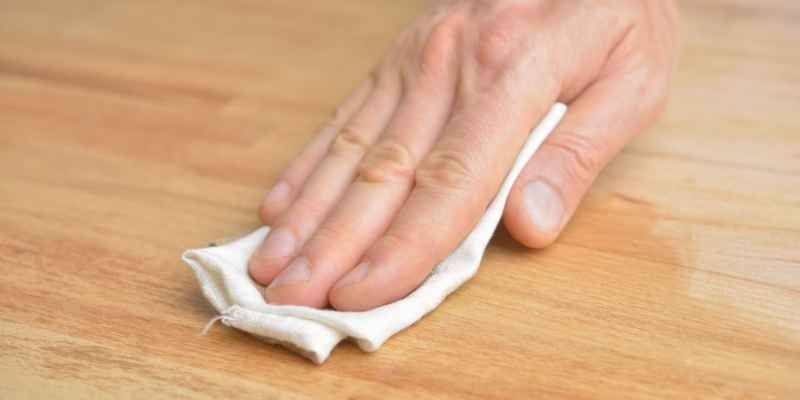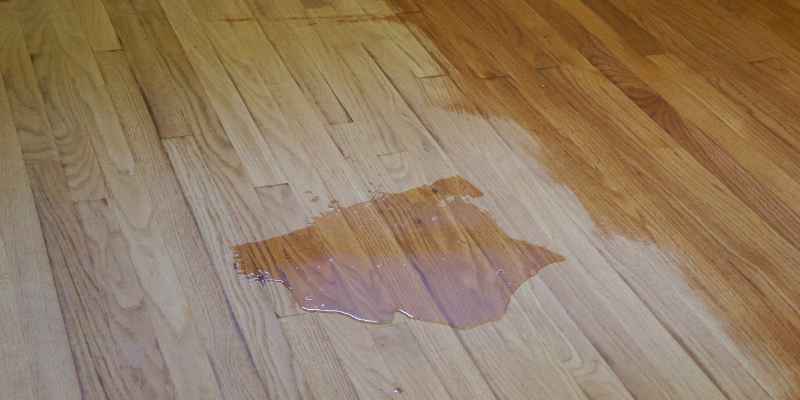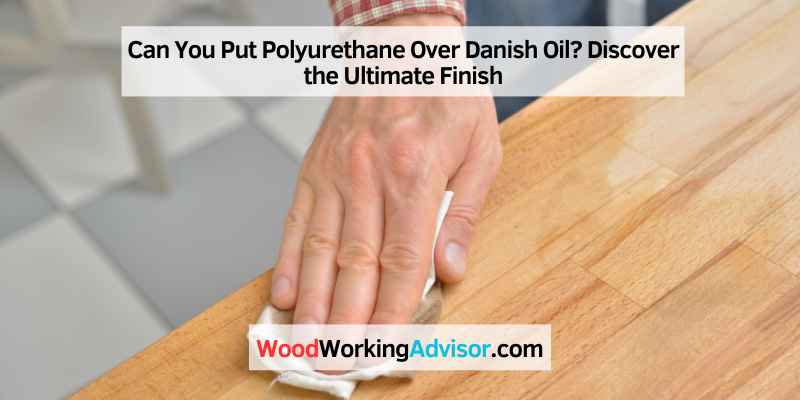Yes, it is possible to apply polyurethane over Danish oil. Danish oil provides a durable, warm finish, while polyurethane adds extra protection and durability to the wood surface.
By combining these two finishes, you can achieve a beautiful and long-lasting result.
What Is Polyurethane?
Polyurethane can be applied over Danish oil to provide a protective topcoat. This combination creates a durable and glossy finish that enhances the natural beauty of the wood while offering excellent protection against wear and tear.
Polyurethane is a versatile and durable coating that is commonly used to protect wood surfaces. It is a type of synthetic resin that forms a hard, clear finish when applied. Polyurethane creates a protective layer that is resistant to moisture, heat, and chemicals, making it ideal for use on furniture, floors, and other wooden items.
What Is Danish Oil?
Danish oil, also known as penetrating oil, is a wood finish that is designed to enhance the natural beauty of the wood while providing some protection. Unlike polyurethane, Danish oil is a penetrating finish, meaning it is absorbed into the wood rather than forming a hard, protective layer on top.
Differences Between Polyurethane And Danish Oil
While both polyurethane and Danish oil can be used to finish wood, they have some key differences that make them suitable for different applications.
- Polyurethane forms a hard, protective layer on top of the wood, while Danish oil penetrates the wood fibers.
- Polyurethane provides a high level of protection against moisture, heat, and chemicals, while Danish oil offers moderate protection.
- Polyurethane creates a glossy or satin finish, while Danish oil enhances the natural appearance of the wood with a low sheen.
- Polyurethane is more resistant to wear and tear, making it ideal for heavily used surfaces like floors, while Danish oil is better suited for items that require periodic maintenance, such as furniture.
Ultimately, the choice between polyurethane and Danish oil depends on the desired look, level of protection, and intended use of the wood surface.

Can Polyurethane Be Applied Over Danish Oil?
When it comes to wood finishing, it’s important to choose the right combination of products to achieve the desired results. One common question that often arises among DIY enthusiasts and woodworkers is whether polyurethane can be applied over Danish oil. Let’s explore this compatibility and discover the best practices for preparing the surface for a successful polyurethane application.
Compatibility Of Polyurethane And Danish Oil
The compatibility between polyurethane and Danish oil depends on the type of polyurethane being used. Some polyurethane products are specifically designed to be used over oil-based finishes, such as Danish oil. These types of polyurethane have a formula that allows them to adhere effectively to the oily surface of the Danish oil, providing a protective layer.
However, it is important to note that not all polyurethane products are suitable for application over Danish oil. Water-based polyurethane, for example, may not adhere properly to the oily surface and could result in peeling, bubbling, or other issues. Therefore, it is crucial to check the product label or consult the manufacturer’s guidelines to ensure compatibility.
Preparing The Surface For Polyurethane Application
Before applying polyurethane over Danish oil, proper surface preparation is essential to ensure adhesion and a smooth finish. Here are some steps to follow:
- Clean the surface: Remove any dirt, dust, or debris from the surface using a damp cloth or vacuum cleaner.
- Sand the surface: Lightly sand the surface with fine-grit sandpaper to create a better bonding surface and remove any glossy sheen from the Danish oil. Wipe away the sanding dust with a tack cloth.
- Apply a sealant: If desired, apply a thin coat of dewaxed shellac as a barrier between the Danish oil and polyurethane. This prevents possible compatibility issues between the two finishes.
- Test compatibility: Before applying the polyurethane to the entire surface, it is recommended to test compatibility on a small, inconspicuous area. Apply a small amount of the polyurethane and allow it to dry according to the product instructions. Check for any negative reactions such as peeling or discoloration.
- Apply polyurethane: Once you have confirmed compatibility, apply the polyurethane using a brush, roller, or sprayer, following the manufacturer’s instructions. Allow the first coat to dry completely before applying additional coats if desired.
In conclusion, polyurethane can be applied over Danish oil if you choose a compatible product and prepare the surface properly. By following these guidelines, you can achieve a beautiful and durable finish that protects your woodwork for years to come.
Advantages Of Applying Polyurethane Over Danish Oil
When it comes to finishing wood surfaces, there are several options to choose from. Danish oil and polyurethane are two popular choices known for their protective and enhancing qualities. However, there are distinct advantages to opting for polyurethane over Danish oil. In this section, we will explore these advantages in detail, highlighting how polyurethane can provide enhanced protection, durability, and improved appearance to your wood surfaces.
Enhanced Protection And Durability
One of the primary advantages of applying polyurethane over Danish oil is the enhanced protection it offers. Polyurethane forms a protective layer on the surface of the wood, shielding it against moisture, scratches, and other damages. This durable coating acts as a barrier, making your wood surfaces more resistant to wear and tear.
Moreover, polyurethane provides superior protection against heat, making it an ideal choice for surfaces exposed to sunlight or heat sources. The strong chemical bonds in polyurethane create a robust shield that protects the wood from warping, cracking, or fading, ensuring long-lasting durability.
Improved Appearance And Sheen
In addition to its protective qualities, polyurethane can significantly enhance the appearance of your wood surfaces. When applied correctly, polyurethane forms a clear and glossy finish that adds depth and richness to the wood grain. This improved appearance gives the wood a stunning, professional look, making it more visually appealing.
The glossy sheen provided by polyurethane intensifies the natural beauty of the wood, bringing out its unique features and character. This lustrous finish not only enhances the aesthetics but also adds a touch of elegance to any wooden furniture or flooring.
Step-by-step Guide: Applying Polyurethane Over Danish Oil
Looking to add a protective polyurethane coat over your Danish oil finish? If you want to enhance the durability and longevity of your wood furniture or surfaces, applying polyurethane over Danish oil is a great option. Not only does it provide an extra layer of protection, but it also adds a beautiful glossy finish that enhances the natural beauty of the wood.
Step 1: Clean And Sand The Surface
Before you begin applying polyurethane over Danish oil, it’s essential to start with a clean and smooth surface. Use a soft cloth or tack cloth to remove any dust, dirt, or debris. If there are any rough spots or imperfections, gently sand them down using fine-grit sandpaper. This step ensures that the polyurethane adheres properly and provides a smooth finish.
Step 2: Apply Polyurethane Over Danish Oil
Now it’s time to apply the polyurethane over the Danish oil. Start by stirring the polyurethane thoroughly to ensure an even consistency. Using a clean brush or foam applicator, apply a thin and even coat of polyurethane over the Danish oil finish. Work in the direction of the wood grain to ensure a smooth and even application. Make sure to apply enough pressure to spread the polyurethane evenly, but avoid overbrushing to prevent any streaks or bubbles.
Step 3: Allow Drying And Sanding Between Coats
After the first coat of polyurethane has been applied, you’ll need to allow it to dry according to the manufacturer’s instructions. Typically, it takes around 24 hours for the polyurethane to dry completely. Once dry, lightly sand the surface with fine-grit sandpaper to create a smooth texture for the next coat. Remember to remove any dust or debris before applying the next coat of polyurethane. Repeat this process for two to four coats, depending on the level of protection and shine you desire.
Step 4: Finishing Touches And Maintenance
Once you have achieved the desired number of coats, allow the final coat to dry completely. Gently sand the surface with ultra-fine sandpaper for a smooth and polished finish. If desired, you can also buff the surface with a soft cloth to bring out the shine even more. To maintain the beauty and protection of your wood surfaces, avoid using harsh chemicals or abrasive cleaners. Instead, regularly clean them with a mild soap and water solution and apply a fresh coat of polyurethane every few years.

Considerations And Limitations
When it comes to giving your wooden furniture a beautiful finish, Danish oil and polyurethane are two popular options. But what if you want to enhance and protect your wood with both? Can you put polyurethane over Danish oil? While it is possible, there are considerations and limitations you need to keep in mind.
Applicability To Different Wood Types
Different types of wood react differently to Danish oil and polyurethane. Some woods, such as oak, mahogany, and walnut, are highly compatible with both finishes and can create a stunning result when used together. On the other hand, some softer and oily woods like cedar or pine may not adhere as well to polyurethane, resulting in a less durable finish. So, before applying polyurethane over Danish oil, it is crucial to consider the type of wood you are working with.
Potential Challenges And Solutions
While combining Danish oil and polyurethane can provide added protection and enhance the wood’s appearance, it can also pose challenges. One such challenge is achieving a proper bond between the two finishes. To ensure a successful application, you may need to follow these steps:
- Prepare the surface: Before applying polyurethane over Danish oil, make sure the wood surface is clean and free from dust, debris, and previous coatings. Sanding the surface lightly can help create better adhesion.
- Test in an inconspicuous area: Before proceeding with the entire piece, it is wise to test the combination of Danish oil and polyurethane on a small, inconspicuous area of the wood to ensure compatibility and desired results.
- Apply the polyurethane: Once you are confident about the compatibility, you can proceed with applying polyurethane. Brush it on smoothly and evenly, following the manufacturer’s instructions. Multiple thin coats are usually better than one thick coat.
- Curing and drying time: Allow the polyurethane to cure and dry completely as per the manufacturer’s recommendations. This timeframe can vary depending on the specific product.
- Maintenance and reapplication: Keep in mind that maintaining the finish may involve periodic reapplication of Danish oil and polyurethane, as these protective layers can wear off over time.
By following these suggestions, you can minimize any potential challenges and ensure a successful combination of Danish oil and polyurethane.
Conclusion
To conclude, applying polyurethane over Danish oil is a viable option that enhances the durability and beauty of your woodwork. By following the proper preparation steps and allowing adequate drying time, you can achieve a seamless and long-lasting finish. The combination of Danish oil and polyurethane provides a protective layer that withstands wear and tear while preserving the natural aesthetic of the wood.
Upgrade your wood projects with this winning combination for lasting beauty and functionality.


